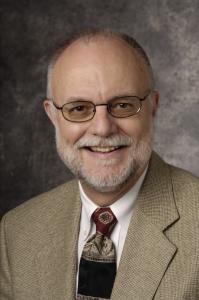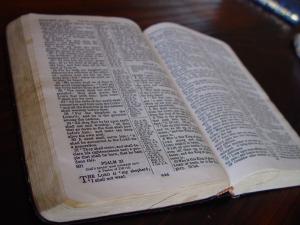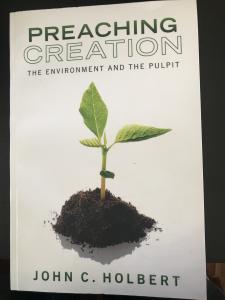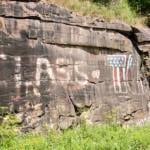 Last week in this blog I said I was going to lead a retreat for an unusual church group found in the unusual town of Los Alamos, NM. I have now lead that retreat, and am now ready to report my impressions of the event.
Last week in this blog I said I was going to lead a retreat for an unusual church group found in the unusual town of Los Alamos, NM. I have now lead that retreat, and am now ready to report my impressions of the event.
I first had a morning in Los Alamos, a town I briefly described last week. It is a wealthy and fairly isolated place at about 7300’ in elevation an hour north of Santa Fe. Of course, its fame resulted in the fact that it was literally ground zero for the Manhattan Project, that astounding group of scientists that designed and exploded the world’s first atomic bomb. The excellent Bradley Museum at the center of town tells this story in fine detail and is well worth a visit. I also went to the historical museum nearby, and learned of the longer history of the location, going back to Native American days. As is true of so many places in the American west, Los Alamos sits on ground long held sacred by tribes that peopled the spot more than a thousand years ago. This has resulted in periodic protests from local tribes, who are saddened and angered by their land’s exploitation and expropriation by the federal government for, in this case, unimaginably horrific and destructive military purposes.
Also, I discovered the history of the Los Alamos Ranch School, a boy’s academy for the sons of very wealthy families, mostly living in the east. Famous students there included Gore Vidal, literary lion and public provocateur, John Crosby, founder and long-time director of the Santa Fe Opera Company, novelist William S. Burroughs, and Arthur Wood, long time president of Sears-Roebuck corporation. When the Manhattan Project was begun, the School was closed and some of its buildings confiscated for government use.
The current town is quite beautiful with a fabulous park at its center with a pristine lake as its crown jewel. And for you devotees of coffee (which I am not), a quite substantial Starbucks may be frequented right at the heart of town. For a community of only 12,000, Los Alamos is well stocked with excellent stores and restaurants.
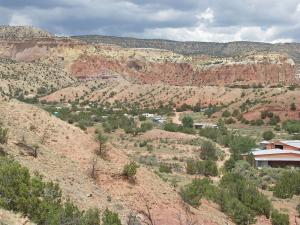 I have not been paid for the Chamber of Commerce advertisement I have just supplied, and I did not go there to ogle the delights of the city. The church’s pastor on Friday PM drove me out to Ghost Ranch, the location of the retreat, some 50 miles further north in the stunning New Mexico mountains. As I mentioned last week, the ranch is next to the tiny community of Abiquiu, made famous by the painter Georgia O’Keeffe, who lived there for many years of her long life. The retreat center used to be a ministry of the Presbyterian Church, but some ten years ago, the church divested itself of the property, and it is now run by a private corporation. It is a truly beautiful spot, nestled against the mountains on one side, and open to a long plain leading to further mountains in the distance. One can easily see how a painter like O’Keeffe would be lured by this place.
I have not been paid for the Chamber of Commerce advertisement I have just supplied, and I did not go there to ogle the delights of the city. The church’s pastor on Friday PM drove me out to Ghost Ranch, the location of the retreat, some 50 miles further north in the stunning New Mexico mountains. As I mentioned last week, the ranch is next to the tiny community of Abiquiu, made famous by the painter Georgia O’Keeffe, who lived there for many years of her long life. The retreat center used to be a ministry of the Presbyterian Church, but some ten years ago, the church divested itself of the property, and it is now run by a private corporation. It is a truly beautiful spot, nestled against the mountains on one side, and open to a long plain leading to further mountains in the distance. One can easily see how a painter like O’Keeffe would be lured by this place.
I offered three lecture/discussions on the topic of the environment and the Bible, a particular interest of mine. However, this time I spoke into a crowd of folk, many of whom were far more ready to offer me important insights, at least from the scientific side of my subject. Nearly every participant in the workshop, some fifty men and women, had a close connection with the Los Alamos National Laboratory, that direct heir of the Manhattan Project some 70 years ago. The Lab is still in the primary business of developing advanced weapons and of securing the aging nuclear deterrent that America still possesses. But there is much more to the Lab than that, I discovered. Two of the participants identified themselves to me explicitly as climate scientists who worked at the Lab, the first time, I think, that I had in my audience those whose scientific lives were spent in addressing the climate and its obvious changes. Rather than finding them intimidating to my thoroughly unscientific self, they added immeasurably to my attempts to delineate the biblical resources I find valuable for addressing the issues surrounding a changing climate. In fact, they, as practicing Christians, were very grateful for my efforts to help them find places in the biblical text that serve as support for the work they do as scientists.
And, of course, others in the audience, many of whom were chemists or physicists, were also very glad of the work I was trying to do. It was for me a confirmation from those who know in detail the workings of the universe, and are dedicated to helping the world confront those workings, that what I am trying to do is valuable.
These scientists’ larger and more immediate concern was the general lack of interest and engagement with their work as scientists. Or more bluntly, as one put it, “How in the world can so many Americans still imagine that the earth is only 6,000 years old!” His language was more salty than that, but you get the picture. Scientific knowledge is scant in our land, and that lack of scientific knowledge reaches the very highest positions of our government. Both our current president and vice-president not only deny the reality of climate change, but apparently Mike Pence also denies the reality of evolutionary change. I can easily see how a person with two PhD’s in fields of scientific study—at least four of the retreat participants so identified themselves– would find the denial of evolution as fact—the basic foundation of all chemistry and biology—both pathetic and horrifying. This decorated scientist of the salty language, in fact one of the Lab’s co-directors, pleaded with me to find ways to talk to those sorts of people who simply were ill-informed and thereby not able to assess the information that has been a settled view of the scientific community since Darwin.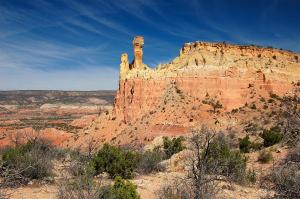
I am all too aware of those religious folk who cannot extend their knowledge into acceptance of these central scientific practices and beliefs. And with my new Los Alamos acquaintances I too am shocked at those who proudly display their appalling ignorance of the most simple and profound findings of our world’s scientists. There remains vast work to do to integrate these learnings into our everyday lives so that we might impact the various parts of our experience that science daily illuminates. Not the least of which is climate change. If one does not accept basic science, one is hardly likely to take with any seriousness the facts that science continually confronts us with.
My few days with these extraordinary people of Los Alamos were richly rewarding for me, giving me hope for the future along with a renewed commitment to do in the theological and church world what these world-class scientists are doing in their spheres to move the world in a better direction. How grateful I am for the opportunity to have been among them; I am sure they gave me far more than I gave to them.
(Images from Wikimedia Commons)


